
by Samantha Kennedy | May 13, 2021
I would like to continue on the theme of reducing food waste by talking more specifically about ways to use food scraps effectively to prevent them from ending up in the landfill.
As I was thinking about this topic, I was reminded of a funny scene from the 1982 film Night Shift, where Michael Keaton’s character, Billy Blaze, says into his tape recorder, “Idea to eliminate garbage: edible paper. You see, you eat it, it’s gone. Eat it, it’s out of there. No garbage.” Think about how much less waste would go into our landfills if we could just eat paper!
It is the same concept for food waste. As much as 40% of food grown, processed, and transported in the United States will never be eaten, destined to end up in the landfill. That is literally thousands of tons of food wasted each year. But what if we could help reduce that amount?

Got leftover veggie scraps? Instead of throwing them away, save them for a delicious veggie soup.
(Photo source: UF/IFAS)
Here are two great ideas for using leftover food scraps instead of throwing them away.
Cook with them. Leftover vegetables are great ingredients for a simple and delicious soup. Simply take the leftovers, combine them with an aromatic base of onions, garlic, and celery, add a liquid such as stock or broth (or water and white wine), throw in a generous helping of herbs, and cook for about 25-30 minutes. Then use an immersion blender or food processor (or stand-up blender) to blend into a creamy soup. Any type of vegetable works for this type of soup, from greens and cauliflower to parsnips and sweet potatoes, which makes it an ideal way to use up those scraps.
Another great way to use vegetable scraps is to make homemade stock. Vegetable parts such as carrot ends and peels, celery ends and greens, corn cobs, pea pods, and all the other bits trimmed off during food preparation can be used to make stock. Not in the mood to make stock right away? No problem! Veggie scraps can be saved in a zippered bag and kept frozen for up to six months.
When the time comes, simply dump the scraps into a large stock pot (that is why it is called a stock pot!) or Dutch oven, fill the pot 3/4 of the way with water, bring to a boil and simmer for at least 30 minutes. (The longer it simmers, the richer the flavor.) Strain it all through a sieve. The remaining liquid is the stock. Fresh stock can be stored 3-5 days in the refrigerator or frozen up to three months. Here is a simple resource from Cornell University Extension on how to make vegetable stock from kitchen scraps. (Here is another one from Tasty.co.)
Hold on! There are still scraps left over. What about those? Well, that brings me to the second great way to use kitchen scraps.
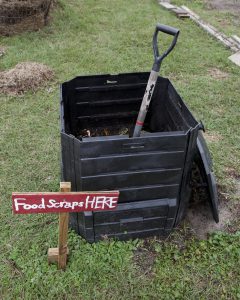
Food waste such as vegetable scraps can be added to compost to create a nutrient-rich fertilizer for home gardens.
(Photo source: Tyler Jones, UF/IFAS)
Compost them. Creating compost at home takes a little work and perseverance, but it can certainly pay off in the home garden. Nutrient-rich compost can add oomph to flower beds and vegetable patches and turn any garden into a showcase.
Vegetable scraps are perfect additions to any compost pile. Any vegetable scraps can be added to compost. Just remember to remove the little stickers, as those are not compostable.
According to the Environmental Protection Agency (EPA), there are many benefits to compost. It enriches soil, helping retain moisture and suppress plant diseases and pests. It reduces the need for chemical fertilizers. And it encourages the production of beneficial bacteria and fungi that break down organic matter to create humus, a rich nutrient-filled material. These fact sheets (this one and this one) from UF/IFAS Extension are a wealth of information about home composting.
The reduction of unnecessary food waste begins with us, the consumers. By learning how to use those scraps in useful ways, such as cooking and composting, we can help eliminate the excess food waste filling our landfills.
UF/IFAS is an Equal Opportunity Institution.

by Samantha Kennedy | Mar 17, 2021
Food waste is a huge problem here in the United States. Here are a few incredible facts: Food is the most common solid source of waste in American landfills. Anywhere from 25-40% of food grown, processed, and transported in the US will never be eaten. Food waste harms the environment and results in a lot of wasted money.
Looking for ways to reduce food waste? Just follow these six tips.
Plan meals carefully. Only purchase what will be eaten in a reasonable amount of time, especially perishable items. Buying large quantities of fresh produce, dairy, and other perishables may seem like a time-saving practice. However, throwing spoiled food away not only wastes money, but also time, since the spoiled items need to be replaced during another trip to the market.
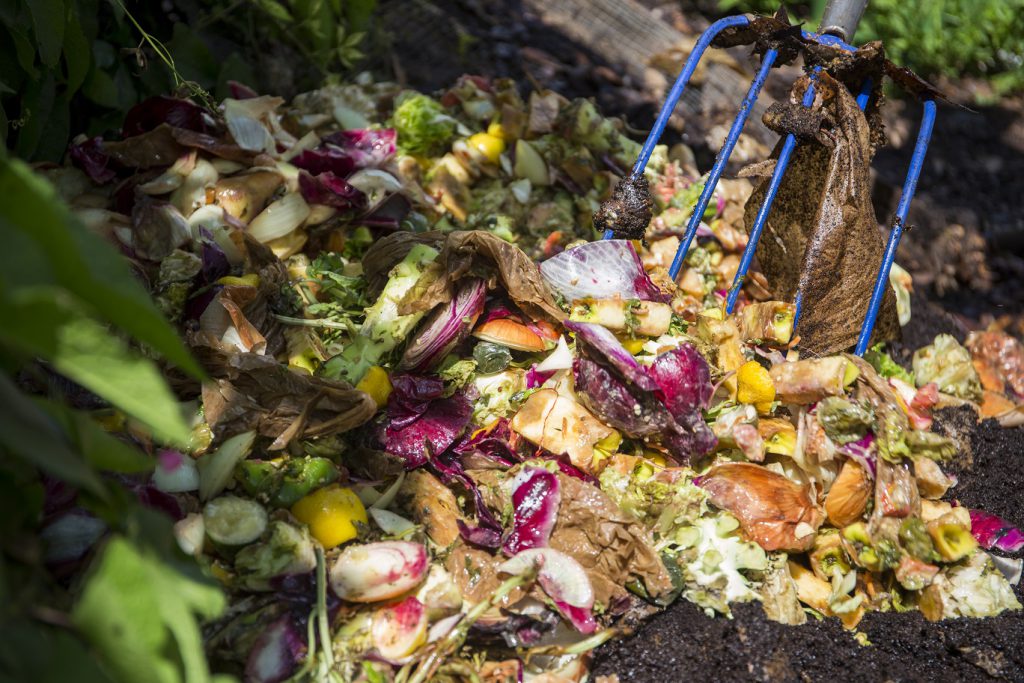
Instead of throwing old fruits and vegetables away, turn them into nutrient-rich compost to help your garden thrive. (Photo source: Camila Guillen, UF/IFAS)
Freeze or re-use food whenever possible. Not all food freezes well. However, fresh fruits and vegetables freeze quickly and easily when handled properly and can last in the freezer for months. Vegetable scraps are also great for making compost, which enriches the soil and can help support the growth of backyard gardens.
Look at the sell by/use by/best by dates on food products. Try to purchase items with the longest shelf-life (the latest date) available. If a product is close to its sell by date, be sure to use it or freeze it quickly. Keep in mind, however, that just because a product is past its use by date does not mean it is unsafe to eat. Take it on a case-by-case basis. If there is no mold, pests, off odors, off colors, or off textures, the product is safe to consume. This is especially true for dry, non-perishable items.
Store food properly. Storing foods at the wrong temperatures can speed up the spoilage process. Keep the refrigerator between 37 and 39 degrees Fahrenheit. Dry goods storage should ideally be around 50 degrees F, but since this is not realistic for most of us, just make sure dry goods are stored in a cool, dry place outside of direct sunlight.
Stay organized. Arrange items so that the oldest stuff is in front. This helps ensure it is used first. Always label frozen foods with the item name and date it was first frozen and use within 12 months whenever possible. Foods frozen for longer than a year start to diminish in flavor and texture. Old food also tends to attract pests, so making sure things are used efficiently can help eliminate the risk of insects and rodents.
Donate non-perishables to those in need. Food banks and other community organizations are always looking for food donations to help the hungry. Non-perishable foods that have not surpassed their use by/sell by dates are always welcome donations. Instead of trashing it, share it with someone less fortunate.
In most cases, food affected by flood damage or other disasters should be discarded for safety reasons. Better to be safe than sorry. However, everyday food waste is completely avoidable if a few simple rules are followed. The amount of food thrown away each year in the US is disheartening. When shopping, being a little more mindful of quantities and dates can help reduce overall food waste, saving both money and the environment.
Additional Resources:
National Center for Home Food Preservation (University of Georgia Extension)
Food Waste Resources (Kansas State University Extension)
UF/IFAS is an Equal Opportunity Institution.

by Samantha Kennedy | Apr 10, 2019

One way to be more sustainable when shopping for groceries is to use reusable shopping bags. They’re durable and sturdy and can help reduce the number of plastic bags that end up in the landfill each year. (Photo source: Samantha Kennedy)
Sustainability should not just be a buzzword during Earth Month. The fact that everybody either shops for or eats groceries means the whole grocery shopping experience is a good time to reflect and improve upon what we can personally do to embrace issues of sustainability.
This year in April, the Earth Month theme focuses on Returning to Nature. There is no better place to start a quest for personal sustainable improvement than the grocery store! Grocery shopping truly embraces the three main areas of sustainability: environmental, economic, and social. In fact, it has been well documented that the average family wastes about 25% of the food it purchases. (Much of this ends up in a landfill and creates problems of its own.)
With a bit of forethought, meal planning before grocery shopping can help individuals and families apply sustainable best practices for environmental, economic, and social well-being. In fact, many of the principles of sustainability can be effectively applied to both meal planning and grocery shopping.
RESPECT yourself. Good nutrition is one of the keys to a healthy life. Improve health by keeping a balanced diet. Vow to make healthier food choices for personal health and the environment.
REFUSE to use food products that do not fit your principles of sustainability. This may mean buying food with less packaging, eating more locally-grown fruits and vegetables, or looking for foods labeled as more responsibly sourced.
REDUCE the amount of food thrown out. Planning meals ahead of time and writing out a grocery list are excellent ways to start living sustainably. Planning not only saves money on groceries, it can save time and decrease the amount of personal food waste a family contributes. (Remember, freezing products can prolong their life, so if you find that you’ve overbought, try preserving some of your bounty for later use.) Reducing the number of trips to the grocery store also can help save on fuel and transportation costs.
REUSE /REPURPOSE food for another occasion. Careful meal planning helps ensure that leftovers from one meal can be incorporated into the next one, thereby reducing food waste.
RETHINK! Healthy, nutritious, delicious, and inexpensive grocery choices can be found in every food group. Not all food has to be prepackaged. In fact, with a bit of planning, dinner can be on the table in 15 minutes. (That’s less time than it takes to wait in line at a fast food restaurant.)
BE RESPONSIBLE! Use what you buy.
Stock up on low-cost healthy grain products like whole-wheat noodles, brown rice, and store-brand cereals and oatmeal.
Purchase fruits and vegetables that are in season and cost less. In addition, do not forget that frozen, dried, and canned fruits and vegetables can play an important part in meal planning.
Buy the largest size you can effectively use before it reaches the expiration date – and look for the items with the latest dates. Purchase store brands or generic brands whenever possible. Keep in mind smaller containers tend to cost more, no matter what the food group. Buying larger packages and dividing them into smaller portions can save money and reduce the amount of packaging that ends up in the landfill. Investing in small, reusable storage containers will save money and reduce waste in the end.
Practice Meatless Monday. The protein group provides inexpensive protein sources like beans, lentils, and eggs, which can be substituted for meat in many meals.
Protein does not have to be the most expensive item purchased. Consulting the store’s weekly sales flyer during meal planning can help you plan meals around meat and poultry items that are on sale.
Prepare food your family will actually eat. There are two schools of thought here: preparing just enough for one meal or preparing big-batch recipes that provide leftovers which can be frozen for later use. Either practice can be sustainable. Freeze leftovers only if you’re going to use them. Otherwise, cut down on the amount of food cooked to help reduce food waste.
Learn how to cook. Prepare and eat more meals at home. It is sustainable, good for you, and delicious. Meals cooked at home are more nutritious, less expensive, and result in less overall waste, such as packaging.
Two additional ways to be more sustainable when grocery shopping are to use reusable shopping bags and to stop using single-use plastic produce bags. Plastic grocery bags choke our landfills and end up in our water bodies. They are not biodegradable and can last thousands of years virtually intact. Reusable shopping bags are made from recycled materials and can drastically reduce the number of plastic bags that end up in the trash each year.
For more information on making your grocery shopping more sustainable, check out these related articles:
Freezing: Nature’s Pause Button (UF/IFAS Extension)
What’s in your FREEZER? (UF/IFAS Extension)
Best Practices for Shoppers at the Farmers’ Market (UF/IFAS Extension)
Sustainable Grocery Shopping (University of Northern Iowa)
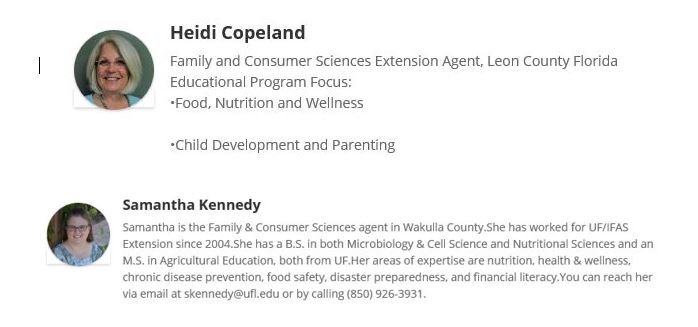
UF/IFAS Family and Consumer Sciences Agents Heidi Copeland and Samantha Kennedy
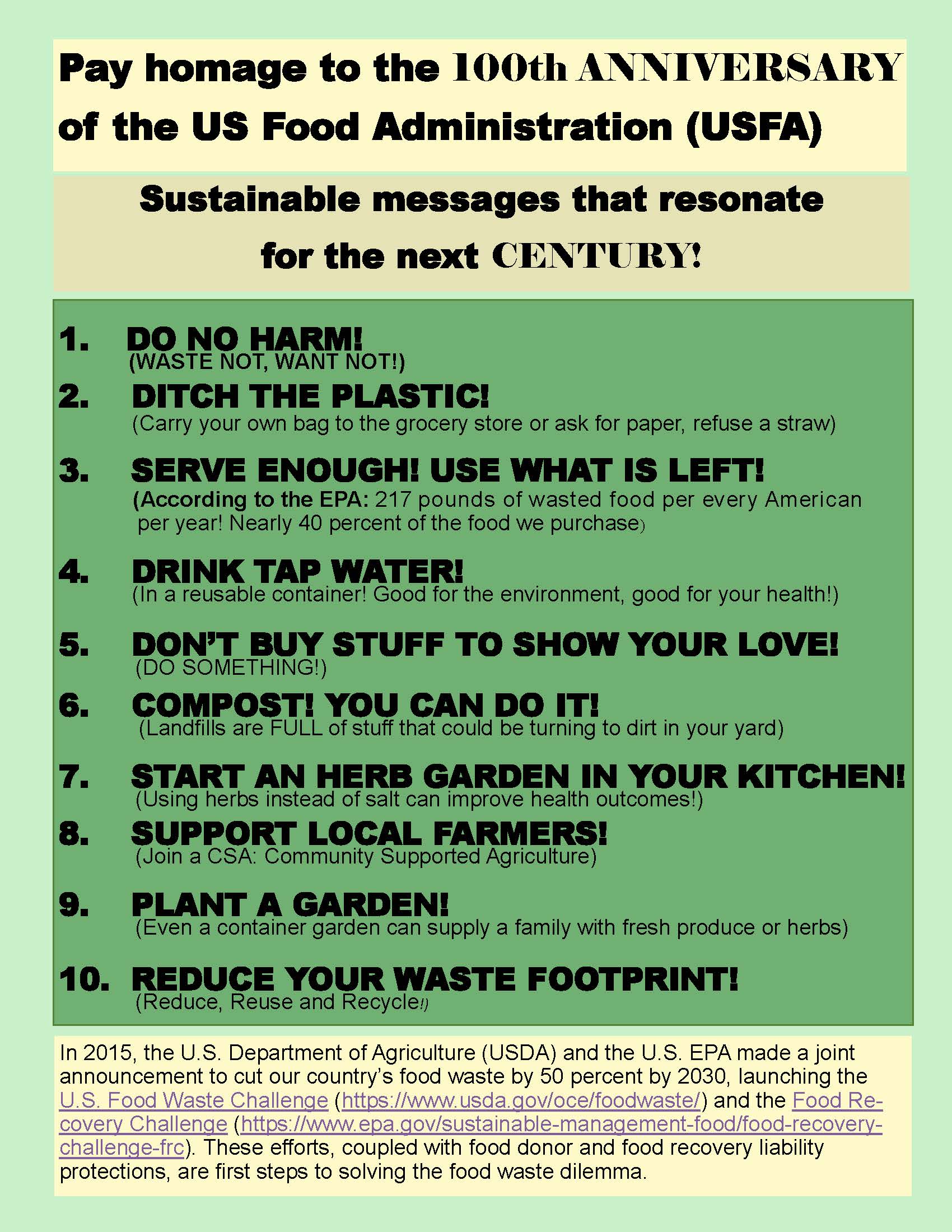
by Heidi Copeland | Mar 2, 2018
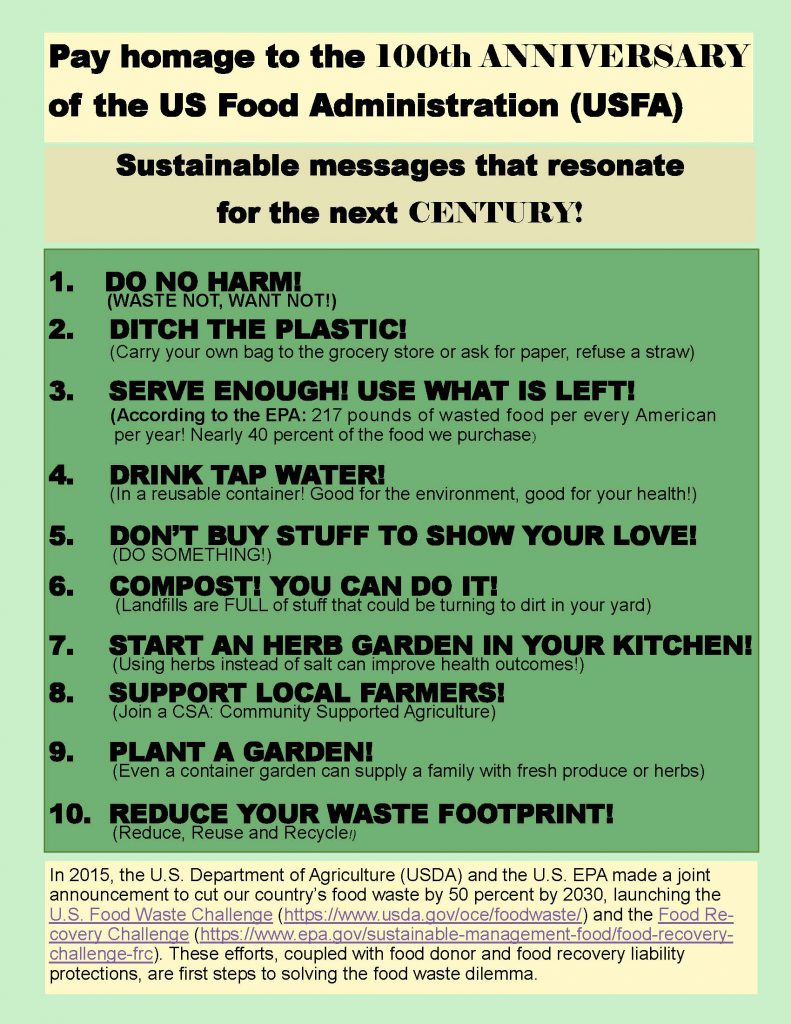
Photo credit: NW Extension District
Sustainability!
According to the Environmental Protection Agency (EPA), the term sustainability has emerged because of significant concerns about the unintended social, environmental, and economic consequences of our world’s rapid growth. Sustainability is based on the simple principle: Everything we need for our survival and well-being depends, either directly or indirectly, on our natural environment. Therefore, sustainability creates and maintains the conditions under which humans and nature can exist in harmony, fulfilling the social, economic, and other requirements of present and future generations.
WHEW! A mouthful, to be sure. Nevertheless, issues of sustainability are often overlooked on the individual level.
Did you know that during the United States’ (US) participation in World War I (from 1917 – 1918), the US had a US Food Administration (USFA) agency? This agency was responsible for food distribution to the US Army overseas and the Allies’ food reserves. This agency also organized a campaign to encourage Americans to support this effort through individual food conservation messages, media campaigns, and food education programs.
Now, 100 years later, this food conservation effort is still applicable.
Everyone can do his or her part in combating waste of all kinds. According to the USDA, reducing consumer-level loss is an important step toward reducing food waste in the United States. USDA estimates that almost 30 percent of the available U.S. food supply was lost from human consumption at the retail and consumer levels.
Every one of us can promote practices to strengthen our natural environment and quality of life. Even the EPA has some suggestions for reducing personal food waste:
- Shop your refrigerator first! Cook or eat what you already have at home before buying more.
- Plan your menu before you go shopping and buy only those things on your menu.
- Buy only what you realistically need and will use. Buying in bulk only saves money if you are able to use the food before it spoils.
- Be creative! If safe and healthy, use the edible parts of food that you normally do not eat. For example, stale bread can be used to make croutons and beet tops can be sautéed for a delicious side dish.
- Freeze, preserve, or can surplus fruits and vegetables – especially abundant seasonal produce.
- At restaurants, order only what you can finish by asking about portion sizes and be aware of side dishes included with entrees. Take home the leftovers and keep them for your next meal.
- At all-you-can-eat buffets, take only what you can eat.
Reducing food waste – a simple action of sustainability. Let’s give it a try! And pay homage to this 100-year-old sustainability campaign that can resonate for the next century.
For more information, visit https://www.usda.gov/oce/foodwaste/resources/consumers.htm and
http://edis.ifas.ufl.edu/fy1134









